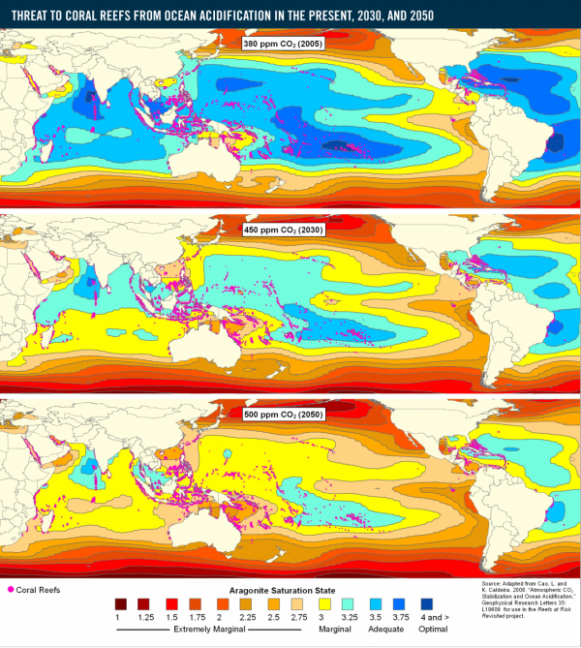We are Looking at the Complete Loss of Tropical Coral
Reefs By 2050 to 2100
“Ecosystems
that have thrived and developed over millions of years are being
smashed down by human activities in just a few decades. It is a very
sad state of affairs that hopefully we can turn around before it is
too late.”
— Ken
Caldeira of Stanford University.
One
trillion dollars. That’s
the economic impact a new UN study found resulting from the world’s
oceans becoming 170 percent more acidic by 2100 under an inexorable
and ongoing human carbon emission.
It’s
a rapidly ramping acidity that is being driven by an ever-rising
level of CO2 in the Earth’s atmosphere. An emission that is already
setting the stage for a first wave of mass extinction in the world
ocean — starting now and hitting high gear once global CO2 levels
reach about 500 parts per million (this year, global CO2 levels
topped off at 401 parts per million and under current and planned
emissions are likely to hit 500 ppm within about 30 years).
At
issue is the vulnerability of coral reefs and many other species with
calcareous skeletons and shells to rapid acidification. In the deep
geological past, we’ve seen mass extinctions in many of these
species due to rapid rises in ocean acidity. Events such as the
Permian and PETM extinctions all showed terrible losses of species
due to ocean acidification alone.
But
the pace at which humans are increasing ocean acidification has never
been seen before in the geological record. So the blow that is coming
to many of the animals we rely on is worse than anything witnessed in
Earth’s deep past.
(Ocean acidification and related impacts to coral reefs through 2050 [500 ppm CO2]. Bands in the marginal and extremely marginal range represent acidity levels in which reefs struggle to survive. Image source: Threat to Coral Reefs From Ocean Acidification.)
Recent
studies have provided numerous highlights to the extraordinary risks
posed to coral reefs over the coming decades. One
study, published in 2011, called into question the reefs’ ability
to survive even through to the 2050 timeframe. A sudden loss that
would be both staggering and unconscionable.
The
reefs themselves are home to more than a million species — all of
whom provide untold and priceless benefits to the Earth and to human
beings alike. The reefs also provide broad support for worldwide
fishing and tourism industries. Without the reefs both a critical
life support and a key support to human civilization simply
dissolves.
It’s
callous to put a price on such an egregious loss. But behind the
massive 1 trillion dollars in economic damages we can glimpse a world
that has also lost a great portion of its beauty and vitality.
Imagine a world barren and bereft of the living jeweled belt of coral
reefs. Imagine desertified oceans, leeched of life as a result. Such
a loss is unconscionable. Like witnessing a holocaust of wonder.
A
stark example of the terrible life, wealth and beauty destruction
engine that is human-driven climate change.
But
that’s what we can look for as ocean PH levels spiral from 8.1
during the 1880s to 8.0 now to 7.9 by or before 2100.
The
study did not assess the added damage also ongoing throughout the
world due to rapid ocean warming, resulting in widespread coral
bleaching. A
major instance of which is now ongoing in Hawaii due to dangerous
ocean temperatures in excess of 86 degrees Fahrenheit.
In
order to prevent a rise of global CO2 levels to 500 parts per
million, we must begin rapidly shutting down global fossil fuel
infrastructure. This includes all emitting infrastructure — coal,
oil, or natural gas. Shutting down coal plants is a good start, but
building gas plants to replace them still results in an easy
overshoot of the 500 ppm level.
Links:
(Hat
Tip to Colorado Bob)





No comments:
Post a Comment
Note: only a member of this blog may post a comment.